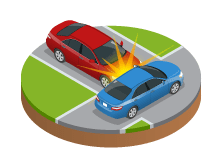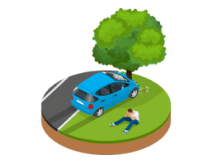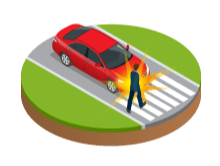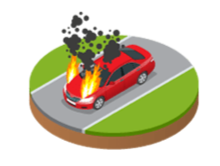Get the cheapest quotes for your car
Compare providers in your area.
Your information is secure
Compare providers in your area.
Your information is secure
North Dakota drivers pay an average of $844.18 per year for car insurance according to the National Association of Insurance Commissioners (NAIC), that’s about $70.35 per month. North Dakota drivers pay about 29% less than the countrywide national average of $1,189.64.
The NAIC takes into account all car insurance policies within the state such as drivers who select only state minimum coverage, as well as policies that include various levels of comprehensive and collision coverage. Because car insurance rates are influenced by personal factors, you could find yourself paying significantly less.

In no-fault states, each driver pays for their own injury-related expenses after an accident.
Drivers in North Dakota are required to carry a minimum amount of liability coverage to legally drive. You may see it written as 25/50/20, but we’ll break down what that means.

North Dakota requires $25,000 in bodily injury liability per person and $50,000 of bodily injury per accident to legally drive. That’s right in line with what most states across the US require for this coverage.
This means $25,000 is the most your insurer will pay for a single person injured by you in an at-fault accident. And $50,000 is the maximum amount your insurer will pay if there is more than one person injured by you in an at-fault accident. Any costs outside of your bodily injury limit are required to come out of your pocket.

North Dakota requires drivers to carry $25,000 of property damage liability to legally drive. This is the highest required property damage limit, but common across the states.
This means $25,000 is the maximum amount your car insurance company will pay towards damages you cause to another person’s car or property, such as repairs to a car, fence or building. You’ll have to pay out of pocket for any costs beyond your property damage liability limit.

North Dakota requires all drivers to carry $25,000 of uninsured motorist bodily injury per person and $50,000 uninsured motorist bodily injury per accident to legally drive. Near half of the states across the US require some sort of uninsured motorist coverage, though some other states let you opt-out.
This coverage protects you if you get hit by an uninsured or underinsured driver. It pays for medical bills for you and your passengers.

North Dakota drivers are required to carry $30,000 worth of personal injury protection to legally drive.
This coverage helps pay your or your passenger’s medical expenses if you’re injured in an accident, regardless of fault.
These state-mandated requirements are the lowest amount of coverage you need to legally drive in North Dakota, but may fall short if you’re in a major accident. To avoid high out-of-pocket costs after an accident, consider raising your liability limits by balancing coverage, your budget and what you can afford to pay out of pocket for certain damage.
The cheapest company won’t look the same for men as for women. In this sample, men might want quotes from Geico. However, Progressive offers the lowest rates for women by far.
| Company | Allstate | Progressive | Geico | USAA |
|---|---|---|---|---|
| Men | – | $114.13 | $112.54 | $132.07 |
| Women | $163.54 | $97.01 | $132.06 | $115.69 |
Progressive offers solid value in North Dakota based on our analysis of sample quotes from Savvy.
If you’re a safe driver, you can save even more with a claim-free discount from Progressive. Or you can join its Snapshot program to get a discount based on how safely you drive.
| Company | Allstate | Progressive | Geico | USAA |
|---|---|---|---|---|
| Rate | $123.57 | $105.57 | $123.70 | $126.61 |
Factors are characteristics specific to you that car insurance companies use to set how much you’ll pay for car insurance. The less risky each of your factors is, the less you pay. And the riskier you are, the more you’ll pay. We’ll break down North Dakota’s rating factors to keep in mind.
| Factor | How it affects your rates |
|---|---|
Age | How old you are is a top factor in determining your car insurance rates. With each passing year, you earn more experience on the road. More experience can equal cheaper rates. Teen drivers pay the most, but rates begin to level off around your 20s with drivers over 50 paying the least. |
Gender | North Dakota takes gender into account when determining your rates. On average, men in North Dakota pay more for car insurance than women. The average annual premium across all age categories for men is $1,233, while women pay an average of $1,219. |
Location | Where you live affects your rates, including where you park your car. High theft rates, high traffic and a high number of uninsured drivers could mean higher rates. When it comes to vehicle theft, North Dakota is a little higher than the national average. For every 100,000 inhabitants, approximately 271 vehicles were stolen, according to Statista. The national average across the US is 246 cars for every 100,000 inhabitants. As for uninsured drivers, 13% of North Dakotans on the road are uninsured. That ranks the state 21st out of 50 states for uninsured drivers, according to Insurance Information Institute. |
Driving Record | The better your record, the lower your premium. If you’re in an at-fault accident you could see rates increases from 20% to 50%. A DUI in North Dakota can increase your rate by an average of 46%. These types of violations typically stay on your record for about five years. North Dakota drivers with a clean driving record pay approximately $743 annually while North Dakota drivers with one speeding violation pay approximately $948 annually. |
Vehicle and mileage | Your car’s make, model and trim directly affect how much you’ll pay for car insurance. Things like its cost, safety ratings, the likelihood of theft and sportiness all help insurers determine its cost to insure. Safer and cheaper vehicles score the lowest rates, with luxury vehicles with higher repair costs resulting in higher premiums. And, the more you’re on the road, the more at-risk you are to get in an accident, which means higher premiums. According to the Bureau of Transportation, North Dakotans drive around 32.5 miles per day, which is under the national average of 36.1 miles per day. |
Credit score | Your credit score is included in your credit-based insurance score which insurers use to help calculate rates. According to the Insurance Information Institute, there is a strong correlation between your insurance score and claims filings. A good credit-based insurance score could mean lower rates. North Dakota insurers charge the highest coverage rates for drivers with poor credit histories. Drivers with good credit scores could see an annual insurance rate of about $1,178. These rates rise to about $1,365 with a fair credit score and approximately $1,915 for those with poor credit. |
Coverage | The more coverage you get and the higher limits you choose, the more protection you’ll have and the more you’ll pay in monthly premiums. If you opt for full coverage car insurance that includes comprehensive and collision, the amount of your deductible weighs into your costs too. Higher deductibles mean lower monthly premiums. Low coverage costs in North Dakota average to about $512 yearly, whereas high coverage can be anywhere around $2,082 on average. |
If you need an SR-22 in North Dakota, your insurance company will file it with the state. You’ll need to meet the requirement for one year from the date that your driving privileges are reinstated, or the date of the accident that led to someone’s death.
SR-22s are required if you have a DUI, get in an accident without insurance, drive with a suspended license, cause an accident leading to someone’s death or commit a felony with a vehicle.
North Dakota’s required coverage goes beyond other state’s, but we recommend a few car insurance add-ons to give you the broadest protection possible.
While North Dakota is a no-fault state, drivers can go beyond the no-fault system to sue another driver in many cases, according to the legal website Nolo. Also, North Dakotans can recover expenses for property damage like a car without restrictions on going to court.
For both of these reasons, think about boosting your liability limits well above the 25/50/25 that the state requires. Talk with your insurance agent or financial advisor about the right coverage level for your situation.
Unless you can pay to replace your car without taking a financial hit, think about adding collision coverage to pay for your car repairs or the value of your car. When you’re at fault in an accident, the other driver’s insurance won’t pay for your car’s damage, and your liability coverage only pays for the damage you cause to the other driver.
Collision coverage costs about $23 per month in North Dakota, according to the NAIC auto insurance database. Let’s say that you experienced $1,500 in car damage. If you opted out of collision and saved the monthly premium, it would take you over five years to recover from this car repair. This coverage gives you this protection without having to save for years on end.
Consider this coverage if . . .
Comprehensive coverage is often called other-than-collision coverage because it covers accidents caused by nearly anything other than a car collision. It covers theft, vandalism, a tree falling on your car, hitting an animal or sliding off of a wet or icy road.
Many of these situations are likely in this state. North Dakotans get their car stolen more often than the average nationwide, and you can expect animal run-ins and heavy rain and snow each year. In fact, North Dakota is the eleventh-worst state for cars hitting deer in the US, according to State Farm’s vehicle-animal collision report.
Consider this coverage if . . .
We’ve pulled the top 10 companies by market share that offer coverage in North Dakota according to S&P Global. Compare top companies by three major rating agencies along with our overall score.
| Provider | BBB Rating | JD Power Rating | NAIC complaint ratio | National market share % | Finder score | Go to site |
|---|---|---|---|---|---|---|
State Farm | A+ | 847/1000 | 1.93 | 16.2 | ★★★★★ 4/5 | |
Geico | A+ | 832/1000 | 1.42 | 13.6 | ★★★★★ 4/5 | |
Progressive | A+ | 830/1000 | 1.05 | 13.3 | ★★★★★ 4/5 | Get Quotes |
Allstate | A+ | 827/1000 | 2.71 | 10.4 | ★★★★★ 4/5 | |
USAA | A+ | 884/1000 | 1.9 | 6.3 | ★★★★★ 4/5 | |
Farmers | A- | 820/1000 | 1.64 | 4.9 | ★★★★★ 4/5 | |
Liberty Mutual | A+ | 827/1000 | 2.2 | 4.7 | ★★★★★ 4/5 | Get Quotes |
Nationwide | A+ | 814/1000 | 2.08 | 2.3 | ★★★★★ 4/5 | |
American Family | A+ | 815/1000 | 1.35 | 2.1 | ★★★★★ 4/5 | |
Auto-Owners | A+ | 847/1000 | 0.86 | 1.3 | ★★★★★ 4/5 |
Of North Dakota’s largest cities, Grand Forks has the cheapest rates and Bismarck has the most expensive car insurance rates. Bismarck drivers could face rates 1.5 times more than Grand Forks drivers.
| Company | Annual car insurance rate |
|---|---|
| Allstate | $601 |
| 21st Century | $499 |
| Farmers | $610 |
| Metromile | $470 |
| Geico | $668 |
| Company | Annual car insurance rate |
|---|---|
| Allstate | $600 |
| 21st Century | $541 |
| Farmers | $606 |
| Metromile | $451 |
| Geico | $640 |
| Company | Annual car insurance rate |
|---|---|
| Allstate | $540 |
| 21st Century | $492 |
| Farmers | $562 |
| Metromile | $468 |
| Geico | $670 |
| Company | Annual car insurance rate |
|---|---|
| Allstate | $554 |
| 21st Century | $547 |
| Farmers | $549 |
| Metromile | $460 |
| Geico | $584 |
| Company | Annual car insurance rate |
|---|---|
| Allstate | $601 |
| 21st Century | $519 |
| Farmers | $615 |
| Metromile | $470 |
| Geico | $668 |
The North Dakota Automobile Insurance Plan can help high-risk drivers find minimum insurance coverage by assigning them to one of several area providers. All North Dakota car insurance companies are required to participate in the plan, so that every driver on the road is provided proper coverage. However, if you apply for coverage through the NDAIP, you can probably expect to pay more for your car insurance.
North Dakota is a no-fault state, which means that you pay for your own medical bills, lost income and other injury expenses after an accident, no matter who’s at fault. File a claim under your personal injury protection for these expenses. However, North Dakota’s no-fault laws don’t apply to property damage like car repairs, according to Nolo.
For property damage, North Dakota considers whether drivers are partially at fault under a modified comparative fault law, Nolo states. Under this law, both drivers are assigned a percentage of fault. Drivers with less than 50% of fault can get paid for damage caused by other drivers.
For example, if you’re 80% at fault for an accident, your insurance will pay 80% of the other driver’s property damage. However, since you’re more than 50% at fault, the other driver isn’t required to pay for your property damage.
Since North Dakota requires you to carry car insurance and because you face financial and legal consequences if you don’t, your best route is to look for a conventional car insurance policy that works for you.
To learn more about these topics, from laws and regulations to finding the best values and policies out there, visit our comprehensive guide to car insurance.
A review of CashUSA, a loan connection service that may match you with lenders offering loans up to $10,000.
Explore different ways you could earn money playing games with GPT apps, Twitch streaming, esports competitions, and trading cards.
Compare highly rated and legit survey sites for your next side hustle, how to maximize your survey earnings, and how to avoid scams.
Learn how to become user tester, how much you can earn, top platforms for user testing, and how to avoid scams.
Learn how to earn money through trusted online surveys, including top platforms, practical tips, and some red flags to watch out for.
Earning extra cash can be as simple as sharing your thoughts. In this guide, we’ll walk you through some of the most trusted survey sites and show you how to get started right away.
Cash Advance loans by amount from $100 all the way up to $1,000 USD.
Bonds, treasury securities, blue chip stocks, ETFs, REITs, CDs and annuities are some of the best investments for retirees.
GoHenry is now Acorns Early. If you’re looking for a GoHenry alternative, try Greenlight, Step, Current, Modak Makers or Chase First.
Top apps like Self that build credit include Kikoff, Grow Credit, Chime Secured Credit Builder Card, Credit Strong and Cleo.